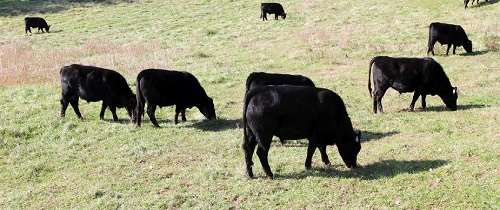In hot, dry years beef cow evaluation and selective culling of the herd can allow for better management of limited resources and enhance the average production per animal to boost herd productivity in future years.

When resources are abundant and calf prices are high, it is tempting to retain cows that are not pulling their weight in adding to your bottom line. While such animals reduce one’s profitability regardless of scenario, utilizing selective culling to eliminate these individuals is of utmost importance for management of the herd in times when climate fluctuations lead to lowered nutrient availability. By culling low producing individuals, the overall herd size is reduced allowing hay and pasture to be better stretched among remaining animals. Furthermore, income from the marketing of culled animals can be used to purchase hay or feedstuffs for the upcoming winter. The following checklist outlines criteria that should be considered when evaluating the cowherd, and may be of special relevance in low resource availability years when stringent culling is necessary.
- Pregnancy Status: Regardless of climate and market reports, cows that do not produce a calf annually reduce profitability and consume resources needed by their productive herdmates. Open cows should be identified and culled following the conclusion of the breeding season. If you do not have a defined breeding season, keep in mind that a cow must conceive within roughly 80 days of calving to maintain a 365-day calving interval. If she’s open for months longer, she’s not earning her keep. Work with a veterinarian to establish dates for pregnancy examination by palpation or ultrasound, or consider utilizing blood samples sent to a diagnostic lab to determine pregnancy status.
- Teeth/Eyes/Feet/Udder: Animals with physical limitations may slip through the culling process in high resource availability years. However, animals unable to easily travel and consume available forage are more likely to lose condition and experience reduced productivity than their physically capable herd mates, and animals with poor udder/teat quality may experience calf loss following birth if suckling is prevented. Culling such animals before a fall calving season and the start of winter feeding eliminates candidates for lowered productivity up front, and marketing these animals before rapid weight loss or health decline results in a more desirable final product and higher compensation.
- Body Condition Score (BCS): A BCS allows one to determine the condition of the cowherd. Animals are scored through visual appraisal and external palpation, and a score of 1(emaciated) to 9(obese) is assigned. At calving, beef cows should have a minimal BCS of 5 to allow for maximum productivity. Thin cows approaching the calving season can lead to lowered pregnancy rates in the upcoming breeding season. BCS appraisal at calf weaning, followed by management to improve condition in thin, dry cows allows such animals to gain condition by calving time. On average, a mature beef cow requires 80 pounds of gain to move up one BCS. However, without adequate feedstuffs to allow for proper gain before calving, culling thin cows at weaning minimizes reduced future production of the herd.
- Low production record: Cows that wean late and/or light weight calves pull down the overall productivity of the herd. If conditions require additional culling, look to these animals to lessen your total numbers and increase average productivity per animal.
- Disposition: Culling animals with flighty or aggressive behaviors may reduce frustration, producer injury, and fence/equipment damage.
- Cows calving out of season or that lack uniformity with the herd: Animals that calve in a season differing from the main herd or that differ in frame size, breed composition, or color may be good candidates for marketing in years when low resources lead to necessary reduction of the herd. Producing uniform calves of the same weight, age, and type can pay dividends when it comes time to wean and market calves. Eliminating animals from the herd that prevent such uniformity may improve overall future profitability. Importantly, such animals can be marketed through different avenues than animals culled for the criteria 1-5 listed above to. Quality individuals that don’t calve in your calving season or are not of the same type as the remainder of your herd may fit others’ calving seasons or herd profiles perfectly. Take advantage of value added marketing schemes to reap the full benefit these animals offer.
While each operation differs in goals and objectives, balance usage of the above cow evaluation criteria can help producers make educated culling or selling decisions in times when resources are both bountiful or limited.